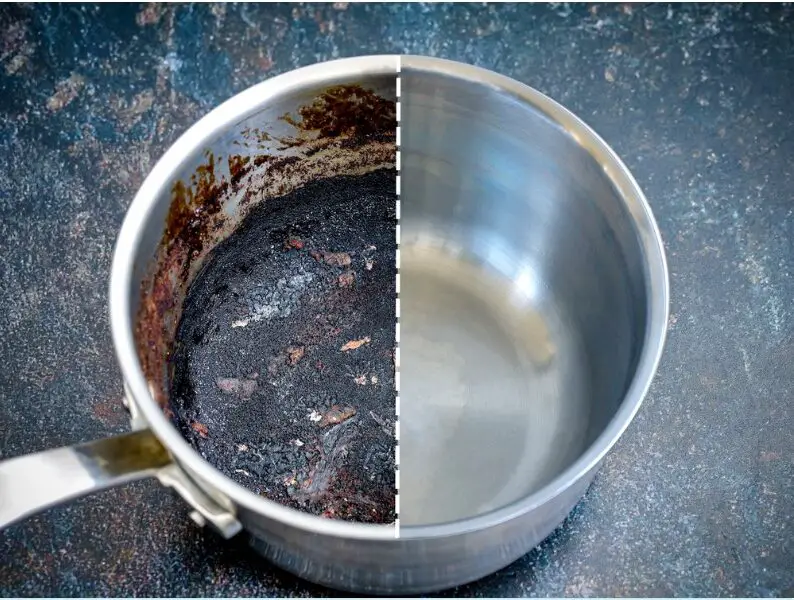How To Remove Burnt Stains From Utensils?

Cooking is an art filled with flavours and aromas, but sometimes, it leaves behind less desirable souvenirs: burnt stains on our beloved kitchen utensils. Whether it’s a scorched pot from a forgotten batch of rice or a pan with a caramelised crust from searing meat, these marks are common in every kitchen. Maintaining the quality and appearance of kitchen utensils is not just about aesthetics; it’s essential for their longevity and functionality. In this post, we’ll explore effective methods on how to remove burnt stains from utensils, ensuring that your kitchen tools remain in pristine condition, and ready for your next culinary adventure.
1 Understanding Burnt Stains
Burnt stains on utensils are a common challenge in the kitchen. These stains occur when food is cooked at too high a temperature or left on the heat for too long, resulting in food substances adhering to and burning onto the surface of materials like steel and aluminium. This phenomenon is often referred to when seeking information on how to remove burnt stains from utensils or looking for tips on how to clean burnt vessel.
Each material has its nuances in how it handles heat and subsequently, how stains need to be cleaned. Steel, for instance, can tolerate high temperatures but is prone to blackened residues from oils and burnt food particles. Aluminium, known for its excellent heat conductivity, might encounter stains that are both stubborn and widespread due to its material properties. Understanding these distinctions is crucial as it guides the selection of cleaning methods tailored to the specific needs of each type of utensil, ensuring effective stain removal and maintenance of the cookware’s quality.

2 Preparatory Steps for Cleaning Burnt Utensils
Before diving into the actual cleaning process, there are several preparatory steps you should take to ensure that you approach the task effectively and safely. The first step in how to clean burnt vessels involves a careful assessment of the material of the utensil, as the approach for steel may differ significantly from aluminium.
- Assess the Material: Determine if your utensil is made from steel or aluminium. This is crucial because different materials require different cleaning agents and techniques. Steel utensils can handle more abrasive methods compared to aluminium, which is more susceptible to scratching and damage.
- Cool Down: Always allow your burnt utensils to cool down completely before attempting to clean them. This prevents any thermal shock to the materials and reduces the risk of burns to yourself.
- Empty the Utensil: Remove any remaining food debris from the utensil. This can usually be done by gently scraping with a wooden or plastic spatula, avoiding further damage to the surface.
- Soak: Fill the utensil with warm water and a mild dish soap to loosen the burnt residues. For steel utensils, you might consider a mixture of hot water and a dishwasher tablet or baking soda to start breaking down the burnt-on food.
- Prepare Your Tools: Gather the appropriate cleaning tools such as non-abrasive sponges, soft brushes, or specially designed scrubbers for steel and aluminium utensils. Avoid using steel wool or metal brushes on aluminium to prevent scratching.
In the following sections, we will delve deeper into how to clean burnt steel utensils and provide specific tips for handling aluminium cookware, ensuring your kitchen tools are restored to their original shine without causing damage.
3 Methods to Clean Burnt Steel Utensils
If you’re wondering how to clean burnt steel vessels effectively, using common household ingredients can be remarkably efficient. Here’s how you can remove those stubborn burnt stains from your steel utensils:
Vinegar and Baking Soda Method
- Create the Mixture: In the burnt steel vessel, mix equal parts of white vinegar and water, then add two tablespoons of baking soda. This combination causes a reaction that helps lift the burnt stains.
- Boil the Mixture: Place the vessel on your stove and bring the mixture to a boil to enhance the cleaning effect.
- Let It Simmer: After boiling, let it simmer for about 15 minutes. This allows the acidic vinegar and the abrasive baking soda to work together to soften and break down the burnt residues.
- Scrub the Stain: Once the mixture has cooled, scrub the vessel with a non-abrasive sponge to remove the burnt stains.
- Rinse Thoroughly: Rinse the utensil with warm water and dry it to see a clean, shiny surface.
Boiling Water and Dish Soap Technique
- Fill and Boil: Fill the burnt steel vessel with water to cover the burnt area, adding a few drops of dish soap. Bring it to a boil.
- Simmer and Soak: Allow the boiling solution to work on the burnt areas for about 10-15 minutes.
- Cool and Scrub: After the vessel has cooled down, use a soft brush or sponge to scrub gently at the burnt residues.
- Repeat for Tough Stains: For particularly stubborn burnt stains on steel utensils, you may need to repeat the boiling process or allow the solution to sit longer.
- Final Rinse: Rinse the vessel thoroughly and dry it with a soft cloth.
These methods are not just effective but also safe for your utensils, ensuring that you know exactly how to remove burnt stains from steel utensils without damaging them.

4 Techniques for Cleaning Burnt Aluminium Utensils
Cleaning burnt aluminium utensils requires special care to avoid damaging their surface. Here are two effective methods to help you tackle burnt stains on your aluminium cookware:
Lemon and Salt Method
- Prepare the Solution: Cut a lemon in half and sprinkle salt generously over the burnt area of the aluminium utensil.
- Scrub with Lemon: Use the lemon half as a scrubber, rubbing it over the salt-covered burnt stains. The acidity of the lemon combined with the abrasiveness of the salt helps to lift the burnt residues.
- Let It Sit: Allow the lemon and salt mixture to sit on the stains for about 30 minutes to penetrate and loosen the burnt particles.
- Scrub Again: After the soaking period, scrub the area again with the lemon half to further remove the loosened burnt residues.
- Rinse and Dry: Rinse the utensil thoroughly with water to remove any remaining lemon and salt residue, then dry it with a soft cloth.
Cream of Tartar Solution
- Create the Paste: Mix equal parts of cream of tartar and water to form a paste.
- Apply the Paste: Spread the paste over the burnt stains on the aluminium utensil, covering them completely.
- Let It Sit: Allow the paste to sit on the stains for at least 1 hour, allowing it to work its magic in breaking down the burnt residues.
- Scrub Gently: After the soaking period, use a soft brush or sponge to gently scrub the burnt areas, applying light pressure to avoid scratching the aluminium surface.
- Rinse Thoroughly: Rinse the utensil with water to remove the paste and any loosened burnt particles, then dry it thoroughly.
By following these techniques on how to clean burnt aluminium utensils, you can effectively remove burnt stains without causing damage to the aluminium surface, ensuring your cookware remains in top condition for years to come.
5 Preventive Measures and Maintenance Tips
Preventing burnt stains on utensils not only preserves their appearance but also extends their lifespan. Here are some valuable tips to help you avoid burnt stains and maintain your kitchen tools:
Tips to Avoid Burning Stains
- Monitor Heat Levels: Pay close attention to the heat settings while cooking to prevent food from burning and sticking to the utensils.
- Use Adequate Cooking Oil: Ensure that you use enough cooking oil or butter to provide a protective layer between the food and the utensil’s surface, reducing the likelihood of sticking and burning.
- Stir Regularly: Stirring food regularly while cooking distributes heat evenly and prevents it from sticking to the bottom of the utensil.
- Use Quality Cookware: Invest in high-quality cookware with non-stick coatings or stainless steel surfaces, which are easier to clean and less prone to burnt stains.
Regular Maintenance Routines
- Immediate Cleaning: After each use, clean utensils promptly to prevent food residues from hardening and becoming difficult to remove later.
- Gentle Cleaning: Avoid using abrasive cleaners or scrubbers that can scratch the surface of the utensils, making them more prone to staining in the future.
- Seasoning Cast Iron: If you use cast iron cookware, regularly season it with oil to maintain its non-stick properties and prevent rusting.
- Proper Storage: Store utensils in a dry and well-ventilated area to prevent moisture build-up, which can lead to mould and mildew growth.
By implementing these preventive measures and maintenance tips, you can significantly reduce the occurrence of burnt stains on your utensils and keep them looking and functioning like new for years to come.
6 Wrapping Up
Maintaining clean and stain-free utensils is not just about aesthetics; it’s essential for preserving their quality and extending their lifespan. By following the methods outlined in this guide, you can effectively remove burnt stains from your cookware and keep them in top condition for years to come.
Regular cleaning and proper maintenance not only enhance your cooking experience but also ensure that your utensils remain reliable companions in the kitchen. Whether it’s using household ingredients like vinegar and baking soda or opting for gentle techniques like lemon and salt, taking care of your utensils is a worthwhile investment.
So, the next time you encounter burnt stains on your cookware, don’t fret. Armed with the knowledge from this guide, you can tackle the challenge with confidence, knowing that you’re not just cleaning your utensils but also prolonging their lifespan and enhancing your culinary adventures.
FAQ's about How To Remove Burnt Stains From Utensils
Which soda is used for cleaning utensils?
- Cool the Surface: Ensure the stainless steel is cool to the touch before cleaning.
- Wash with Soap: Use warm soapy water and a soft sponge to clean the surface. This removes any loose debris and surface grime.
- Apply Baking Soda Paste: Mix baking soda with a little water to create a paste. Apply this paste to the burnt areas and let it sit for 20-30 minutes.
- Scrub Gently: Use a soft cloth or a non-abrasive scrubber to gently scrub the burnt marks. Do not use steel wool or anything similarly harsh, as it can scratch the surface.
- Rinse and Dry: Rinse the area with clean water and dry with a soft towel.
- Use Vinegar (Optional): For persistent stains, apply white vinegar with a soft cloth and then rinse it off. Vinegar helps to dissolve any remaining discoloration.
- Polish (Optional): For extra shine, you can polish the area with a stainless steel cleaner or olive oil.
How to remove black stains from kadai?
- Soak in Hot Water: Fill the kadai with hot water and add a few drops of dish soap. Let it soak for 30-60 minutes to loosen the stains.
- Scrub with Baking Soda: Drain the water and sprinkle baking soda over the stained areas. Use a non-abrasive scrubber to gently scrub the stains. Baking soda acts as a mild abrasive and helps lift the stains without scratching the surface.
- Use Vinegar and Salt: For tougher stains, mix equal parts of white vinegar and water, add some salt, and bring it to a boil in the kadai. The acidic nature of vinegar and the abrasive properties of salt help remove stubborn stains.
- Scrub Again: After the vinegar solution has cooled, scrub the kadai again with a scrubber.
- Rinse and Dry: Rinse the kadai thoroughly with clean water and dry it with a soft cloth to prevent water spots.
- Season if Necessary: If your kadai is made of cast iron or another material that requires seasoning, apply a light coat of cooking oil and heat it slightly to re-season the surface.
Which chemical is used to clean utensils?
Yes, vinegar can be effective in removing burn stains, especially from cookware and fabrics. Vinegar is acidic, which helps break down the residue that burn stains leave behind. Here’s how you can use it:
- For Cookware: Mix equal parts of white vinegar and water in the affected pot or pan. Heat the mixture until it comes to a boil, then let it simmer for a few minutes. The heat and vinegar combination will help loosen the burn stains. After cooling, scrub gently with a non-abrasive sponge.
- For Fabrics: If the fabric is washable, soak the stained area in a solution of one part vinegar to two parts water. Let it sit for an hour, then wash as usual. For tougher stains, you might apply the vinegar directly to the stain before soaking.
How do you clean burnt utensils with baking soda?
- Remove Loose Particles: Start by scraping off any loose burnt bits from the utensil using a wooden or plastic spatula.
- Create a Paste: Mix three parts baking soda with one part water to create a thick paste.
- Apply the Paste: Spread this paste over the burnt areas of the utensil. If the burn is extensive, you might cover the entire bottom of the utensil with the paste.
- Let It Sit: Allow the paste to sit on the burnt areas for at least an hour, or longer for very stubborn burns.
- Scrub: After the paste has had time to work, scrub the burnt areas with a non-abrasive scrubber or sponge. The baking soda acts as a mild abrasive and helps lift the burnt residue without scratching the surface.
- Rinse and Wash: Rinse off the baking soda paste with warm water. Wash the utensil with dish soap and a sponge to remove any remaining baking soda and burnt residue.
- Dry: Dry the utensil thoroughly with a clean towel.
Does vinegar remove burn stains?
Heat Exposure: Prolonged exposure to high heat can cause discoloration, especially in metal utensils such as stainless steel or aluminum. This is often seen as a rainbow or a dark stain.
Burnt Food Residue: When food burns in a pan or pot, it can leave behind a layer of carbonized residue, which appears as a black stain. This is common in cooking mishaps where food is left unattended.
Oxidation: Metals like aluminum can oxidize when exposed to air and moisture, leading to a black or dark grey tarnish over time.
Chemical Reactions: Certain foods, especially acidic ones like tomatoes or vinegar, can react with the metal of the utensils, causing them to darken. This is more noticeable in aluminum cookware.
Improper Cleaning: Using harsh chemicals or abrasive cleaning tools on utensils can cause scratches and surface damage, which may lead to dark spots or an overall black appearance.
Does vinegar remove burn stains?
Yes, vinegar can be effective in removing burn stains, especially from cookware and fabrics. Vinegar is acidic, which helps break down the residue that burn stains leave behind. Here’s how you can use it:
For Cookware: Mix equal parts of white vinegar and water in the affected pot or pan. Heat the mixture until it comes to a boil, then let it simmer for a few minutes. The heat and vinegar combination will help loosen the burn stains. After cooling, scrub gently with a non-abrasive sponge.
For Fabrics: If the fabric is washable, soak the stained area in a solution of one part vinegar to two parts water. Let it sit for an hour, then wash as usual. For tougher stains, you might apply the vinegar directly to the stain before soaking.
Community Q&A
About This Article
This article has been viewed 723 times.



